Tufted Style System (New Site Part 1)
Introduction
The original inspiration for the look and layout of the articles here was Tufte CSS. Tufte CSS is a set of styles that utilize the principals of designer Edward Tufte for a more organized, readable online article or blog post.
I created Tufted as a set of remark and rehype plugins and a Tailwind typography theme that work together to apply these principals to a humble markdown-powered personal site.
There are quite a few technologies at play here that I'm excited to share, so this the first in a series of articles on my maximally-minimal, BBS-inspired home on the web. It will also serve as a style guide of sorts, utilizingNeedlessly? all the elements available through markdown.
Sections and Initial Headings
<section>
<h2>Sections and Initial Headings</h2>
<p>Tufte CSS...</p>
</section>Tufte CSS relies on more structured and hierarchical HTML than markdown alone
provides.
remark-initial-heading
makes use of various unist utilities to
visit the markdown syntax tree and insert a hidden h2 element for the first
section of the site if one does not exist. This normalizes the hierarchy and
semantic relationships throughout the article, which is great for a table of
contents or for accessibility, and also makes it a bit easier to consistently
break the article into sections.
Next, all the content in the article is wrapped into section tags with
remark-sectionize.
The sections are determined by the placement of h2 tags throughout the
article. Here we're applying more implicit hierarchy to the layout of an
otherwise flat content relationship.^[I love the flatness of markdown for
writing, but it limits styling possibilities.] section is called for by Tufte
CSS to increase spacing between distinct thoughts in an article, much like
chapters in a book. As you'll see later, the sections are also useful in
additional remark processing, and the output HTML has more semantic queues that
may be helpful for SEO.
Figures
Normally using markdown you'd miss out on some nice-to-have markup, like the
figure tag. In Tufted I wanted to offer a form of progressive enhancement for
regular images and iframes (more on that in a bit) as well as supporting more
explicit and complex use cases.
remark-wrap-images
will find top-level image and iframe nodes and wrap them in a figure tag.
This allows for more consistent styling, such as maintaining the right margin
for sidenotes at larger browser widths. These elements could be styled just fine
without figure wrappers, but the CSS might end up more complicated with img
tags and figure.img tags needing to be handled independently. Further, since
all the markup is eventually passed to
mdx-bundler the figure tag gives
me a more generic handle for rich content that may need to special
consideration.
For more complex situations I used the fantastic remark-directive plugin. This allows me to create custom wrappers, which is useful for wrapping other content in a figure, like a code block, and for including caption text that is both semantic and can be styled as a proper caption.
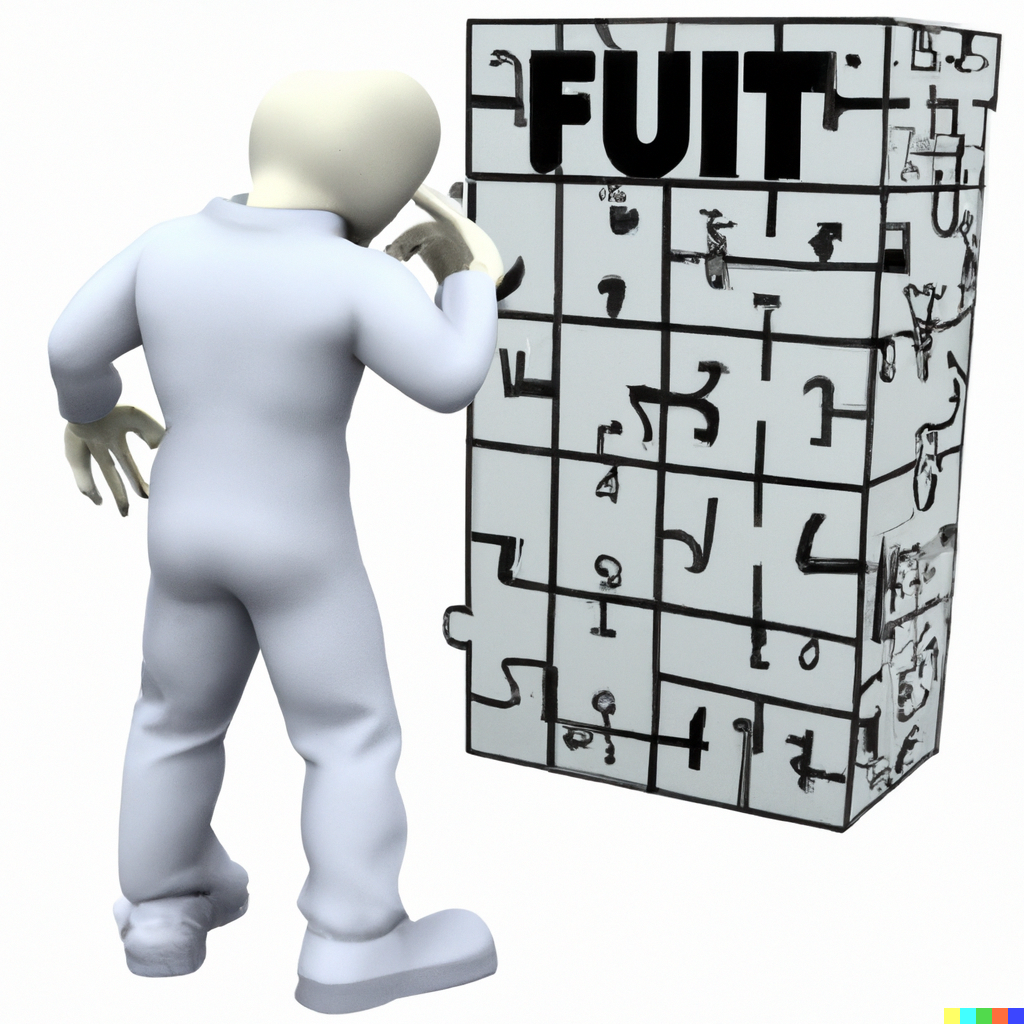
The image above was generated by DALL-E 2, using the prompt "Figure it out!".
:::figure{.fullwidth}
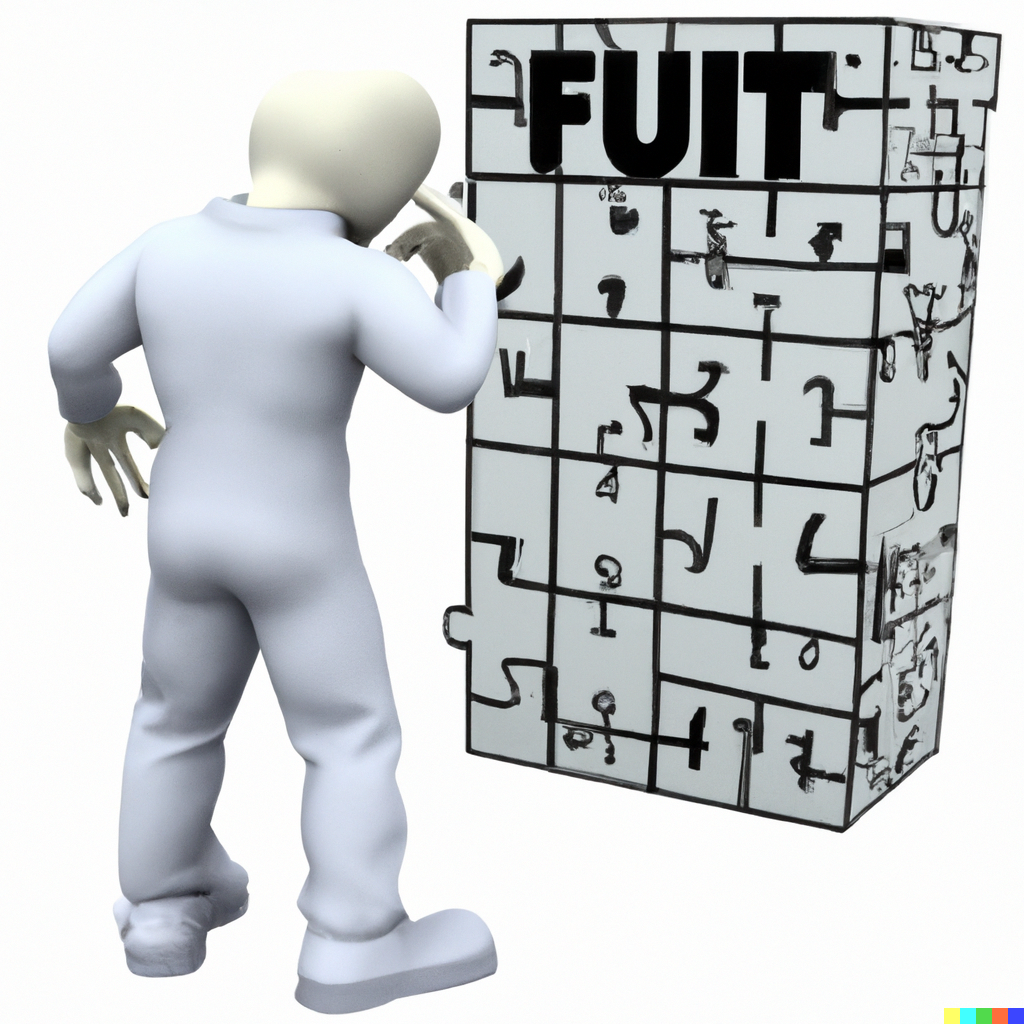
The image above was generated by DALL-E 2, using the prompt "Figure it out!".
:::remark-directive also supports including additional properties, like a
.fullwidth class modifier which allows me to break into the margin.
Videos
remark-directive was also useful in producing an AST that lets me easily
handle YouTube videos. In my
remark-directive-youtube
plugin I'm able to take simple markdown like below and turn it into an iframe
node that is subsequently wrapped in a figure tag. This is good, consistent
markup that supports styling to enforce a ratio that works with my article
layout.
::youtube[Broken World War II Headphones - Restoration]{#98pUBuTar_s}Tufte CSS providesBeautiful Evidence tools to style web articles using the ideas demonstrated by Edward Tufte's books and handouts. Tufte's style is known for its simplicity, extensive use of sidenotes, tight integration of graphics with text, and carefully chosen typography.
Tufte CSS was created by Dave Liepmann and is now an Edward Tufte project. The original idea was cribbed from Tufte-LaTeX and R Markdown's Tufte Handout format. We give hearty thanks to all the people who have contributed to those projects.
If you see anything that Tufte CSS could improve, we welcome your contribution in the form of an issue or pull request on the GitHub project: tufte-css. Please note the contribution guidelines.
Finally, a reminder about the goal of this project. The web is not print. Webpages are not books. Therefore, the goal of Tufte CSS is not to say "websites should look like this interpretation of Tufte's books" but rather "here are some techniques Tufte developed that we've found useful in print; maybe you can find a way to make them useful on the web". Tufte CSS is merely a sketch of one way to implement this particular set of ideas. It should be a starting point, not a design goal, because any project should present their information as best suits their particular circumstances.
Getting Started
To use Tufte CSS, copy tufte.css and the et-book directory of font files to
your project directory, then add the following to your HTML document's head
block:
<link rel="stylesheet" href="tufte.css" />Now you just have to use the provided CSS rules, and the Tufte CSS conventions described in this document. For best results, View Source and Inspect Element frequently.
Fundamentals
Sections and Headings
Organize your document with an article element inside your body tag. Inside
that, use section tags around each logical grouping of text and headings.
Tufte CSS uses h1 for the document title, p with class subtitle for the
document subtitle, h2 for section headings, and h3 for low-level headings.
More specific headings are not supported. If you feel the urge to reach for a
heading of level 4 or greater, consider redesigning your document:
[It is] notable that the Feynman lectures (3 volumes) write about all of physics in 1800 pages, using only 2 levels of hierarchical headings: chapters and A-level heads in the text. It also uses the methodology of sentences which then cumulate sequentially into paragraphs, rather than the grunts of bullet points. Undergraduate Caltech physics is very complicated material, but it didn't require an elaborate hierarchy to organize.
As a bonus, this excerpt regarding the use of headings provides an example of
block quotes. In Tufte CSS they are just lightly styled, semantically correct
HTML using blockquote and footer elements. See page 20 of The Visual
Display of Quantitative Information for an example in print.
In his later booksNeedlessly?, Tufte starts each section with a bit of
vertical space, a non-indented paragraph, and the first few words of the
sentence set in small caps. For this we use a span with the class newthought,
as demonstrated at the beginning of this paragraph. Vertical spacing is
accomplished separately through <section> tags. Be consistent: though we do so
in this paragraph for the purpose of demonstration, do not alternate use of
header elements and the newthought technique. Pick one approach and stick to
it.
Text
Although paper handouts obviously have a pure white background, the web is
better served by the use of slightly off-white and off-black colors. Tufte CSS
uses #fffff8 and #111111 because they are nearly indistinguishable from
their 'pure' cousins, but dial down the harsh contrast. We stick to the
greyscale for text, reserving color for specific, careful use in figures and
images.
In print, Tufte has used the proprietary Monotype BemboSee Tufte's comment in the Tufte book fonts thread. font. A similar
effect is achieved in digital formats with the now open-source
ETBook, which Tufte CSS supplies with a @font-face reference to a
.ttf file. In case ETBook somehow doesn't work, Tufte CSS shifts gracefully to
other serif fonts like Palatino and Georgia.
Also notice how Tufte CSS includes separate font files for bold (strong) and italic (emphasis), instead of relying on the browser to mechanically transform the text. This is typographic best practice.
If you prefer sans-serifs, use the sans class. It relies on Gill Sans, Tufte's
sans-serif font of choice.
Links in Tufte CSS match the body text in color and do not change on mouseover
or when clicked. Here is a dummy example that goes nowhere. These links are
underlined, since this is the most widely recognized indicator of clickable
text. Blue text, while also a widely recognizable clickable-text indicator, is
crass and distracting. Luckily, it is also rendered unnecessary by the use
of underlining. However, because most browsers' default underlining does not clear
descenders and is so thick and distracting, the underline effect is instead
achieved using CSS trickery involving background gradients instead of standard
text-decoration. Credit goes to Adam Schwartz for that technique.
As always, these design choices are merely one approach that Tufte CSS provides by default. Other approaches, such as changing color on click or mouseover, or using highlighting or color instead of underlining to denote links, could also be made to work. The goal is to make sentences readable without interference from links, as well as to make links immediately identifiable even by casual web users.
Epigraphs
The English language . . . becomes ugly and inaccurate because our thoughts are foolish, but the slovenliness of our language makes it easier for us to have foolish thoughts.
For a successful technology, reality must take precedence over public relations, for Nature cannot be fooled.
I do not paint things, I paint only the differences between things.
If you'd like to introduce your page or a section of your page with some quotes,
use epigraphs. Modeled after chapter epigraphs in Tufte's books (particularly
Beautiful Evidence), these are blockquote elements with a bit of specialized
styling. Quoted text is italicized. The source goes in a footer element inside
the blockquote. We have provided three examples in the epigraph of this
section, demonstrating shorter and longer quotes, with and without a paragraph
tag, and showing how multiple quotes within an epigraph fit together with the
use of a wrapper class.
Sidenotes: Footnotes and Marginal Notes
One of the most distinctive features of Tufte's style is his extensive use of sidenotes.This is a sidenote. Sidenotes are like footnotes, except they don't force the reader to jump their eye to the bottom of the page, but instead display off to the side in the margin. Perhaps you have noticed their use in this document already. You are very astute.
Sidenotes are a great example of the web not being like print. On sufficiently large viewports, Tufte CSS uses the margin for sidenotes, margin notes, and small figures. On smaller viewports, elements that would go in the margin are hidden until the user toggles them into view. The goal is to present related but not necessary information such as asides or citations as close as possible to the text that references them. At the same time, this secondary information should stay out of the way of the eye, not interfering with the progression of ideas in the main text.
Sidenotes consist of two elements: a superscript reference number that goes inline with the text, and a sidenote with content. To add the former, just put a label and dummy checkbox into the text where you want the reference to go, like so:
<label for="sn-demo" class="margin-toggle sidenote-number"> </label>
<input type="checkbox" id="sn-demo" class="margin-toggle" />You must manually assign a reference id to each side or margin note, replacing
"sn-demo" in the for and the id attribute values with an appropriate
descriptor. It is useful to use prefixes like sn- for sidenotes and mn- for
margin notes.
Immediately adjacent to that sidenote reference in the main text goes the
sidenote content itself, in a span with class sidenote. This tag is also
inserted directly in the middle of the body text, but is either pushed into the
margin or hidden by default. Make sure to position your sidenotes correctly by
keeping the sidenote-number label close to the sidenote itself.
If you want a sidenote without footnote-style numberings, then you want a margin
note.This is a margin note. Notice there isn't a number preceding the note. On large screens, a margin note is just a sidenote that omits the
reference number. This lessens the distracting effect taking away from the flow
of the main text, but can increase the cognitive load of matching a margin note
to its referent text. However, on small screens, a margin note is like a
sidenote except its viewability-toggle is a symbol rather than a reference
number. This document currently uses the symbol ⊕ (&\#8853;), but it's up to
you.
Margin notes are created just like sidenotes, but with the marginnote class
for the content and the margin-toggle class for the label and dummy checkbox.
For instance, here is the code for the margin note used in the previous
paragraph:
<label for="mn-demo" class="margin-toggle">⊕</label>
<input type="checkbox" id="mn-demo" class="margin-toggle" />
<span class="marginnote">
This is a margin note. Notice there isn’t a number preceding the note.
</span>Figures in the margin are created as margin notes, as demonstrated in the next section.
Figures
Tufte emphasizes tight integration of graphics with text. Data, graphs, and figures are kept with the text that discusses them. In print, this means they are not relegated to a separate page. On the web, that means readability of graphics and their accompanying text without extra clicks, tab-switching, or scrolling.
Figures should try to use the figure element, which by default are constrained
to the main column. Don't wrap figures in a paragraph tag. Any label or margin
note goes in a regular margin note inside the figure. For example, most of the
time one should introduce a figure directly into the main flow of discussion,
like so:
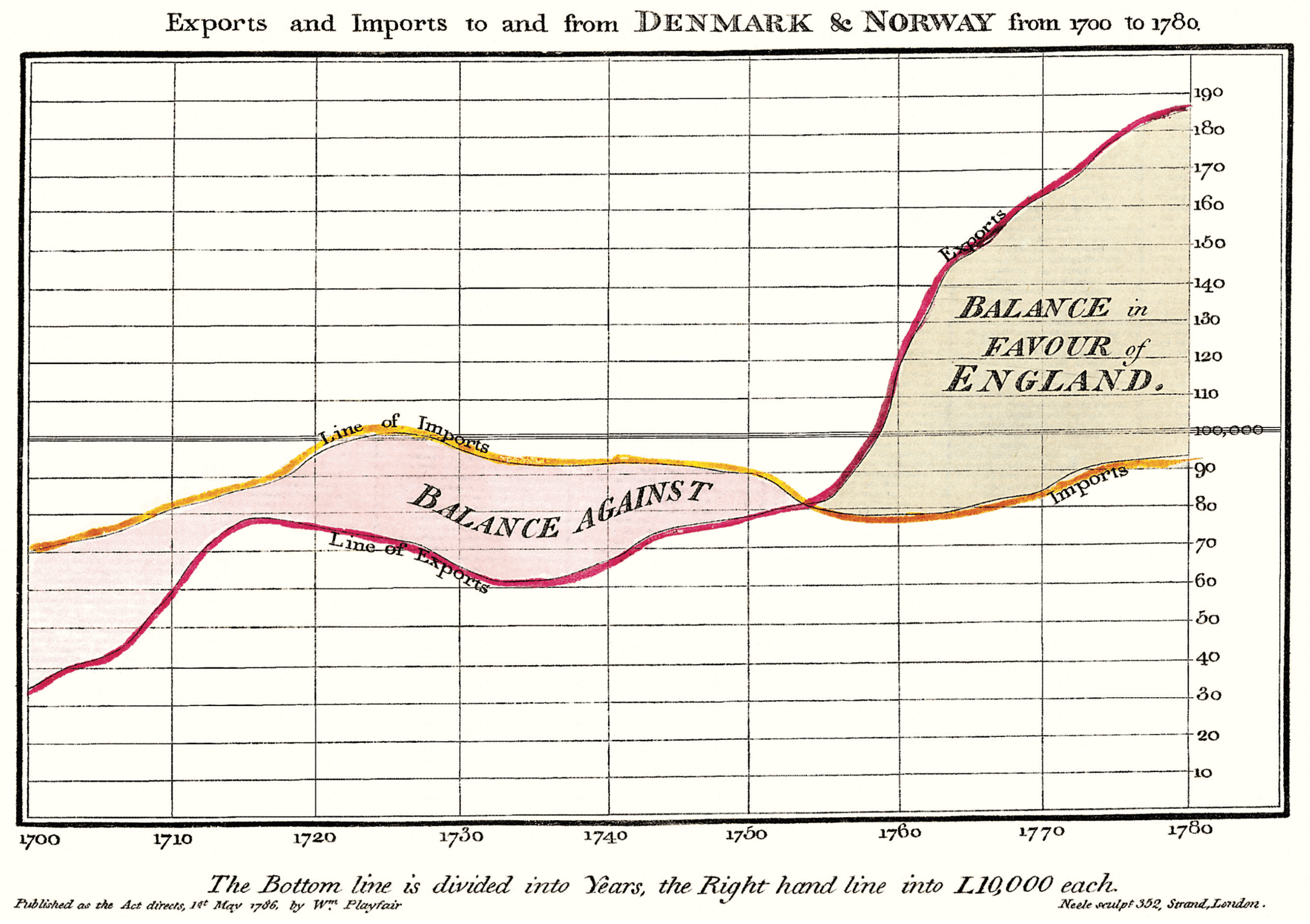
From Edward Tufte, Visual Display of Quantitative Information, page 92.
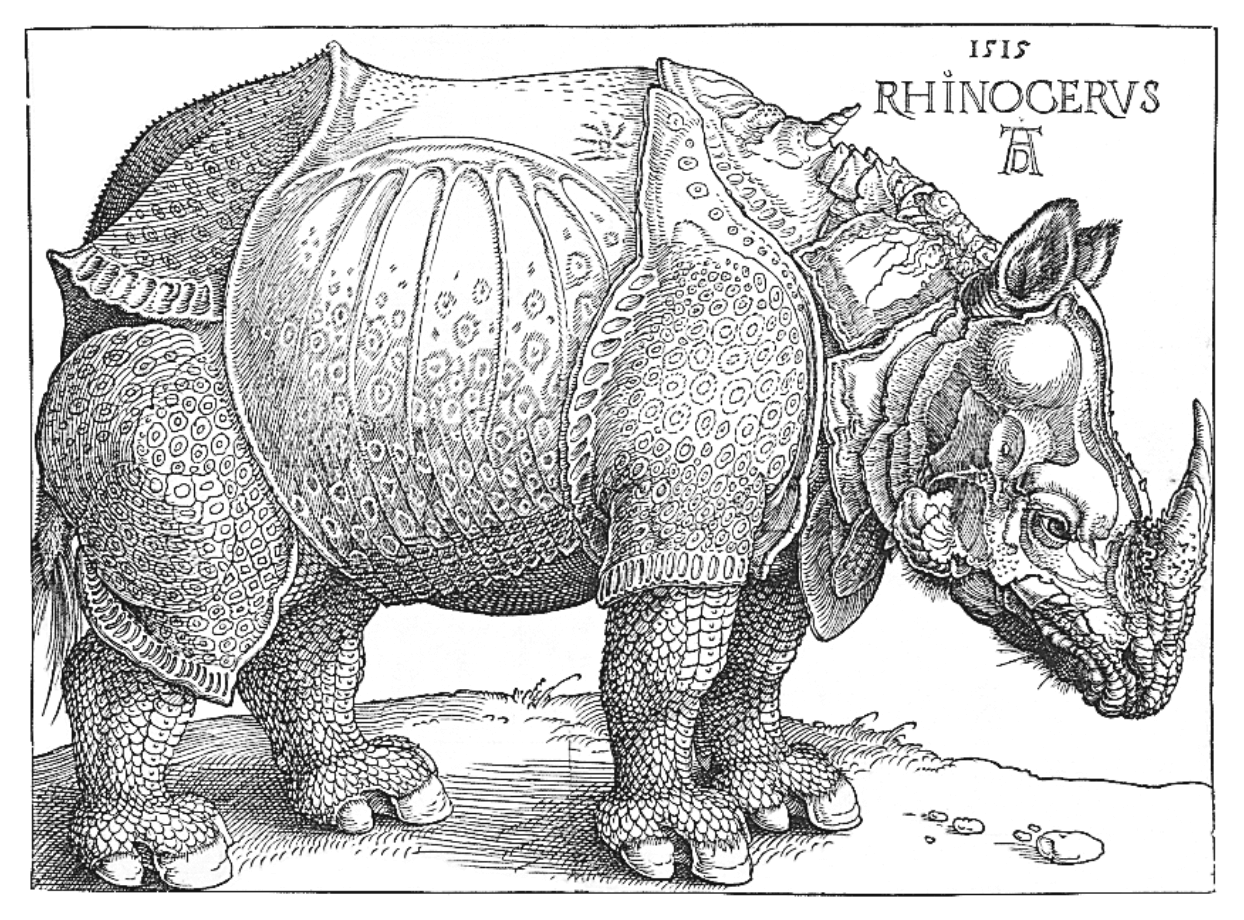 F.J. Cole, "The History of Albrecht Dürer's Rhinoceros in Zooological Literature," Science,
Medicine, and History: Essays on the Evolution of Scientific Thought and Medical
Practice (London, 1953), ed. E. Ashworth Underwood, 337-356. From page 71 of
Edward Tufte's Visual Explanations. But tight integration of graphics with text is central to Tufte's work
even when those graphics are ancillary to the main body of a text. In many of
those cases, a margin figure may be most appropriate. To place figures in the
margin, just wrap an image (or whatever) in a margin note inside a
F.J. Cole, "The History of Albrecht Dürer's Rhinoceros in Zooological Literature," Science,
Medicine, and History: Essays on the Evolution of Scientific Thought and Medical
Practice (London, 1953), ed. E. Ashworth Underwood, 337-356. From page 71 of
Edward Tufte's Visual Explanations. But tight integration of graphics with text is central to Tufte's work
even when those graphics are ancillary to the main body of a text. In many of
those cases, a margin figure may be most appropriate. To place figures in the
margin, just wrap an image (or whatever) in a margin note inside a p tag, as
seen to the right of this paragraph.
If you need a full-width figure, give it the fullwidth class. Make sure that's
inside an article, and it will take up (almost) the full width of the screen.
This approach is demonstrated below using Edward Tufte's English translation of
the Napoleon's March data visualization. From Beautiful Evidence, page
122-124.
Technical jargon, programming language terms, and code samples are denoted with
the code class, as I've been using in this document to denote HTML. Code needs
to be monospace for formatting purposes and to aid in code analysis, but it must
maintain its readability. To those ends, Tufte CSS follows GitHub's font
selection, which shifts gracefully along the monospace spectrum from the elegant
but rare Consolas all the way to good old reliable Courier.
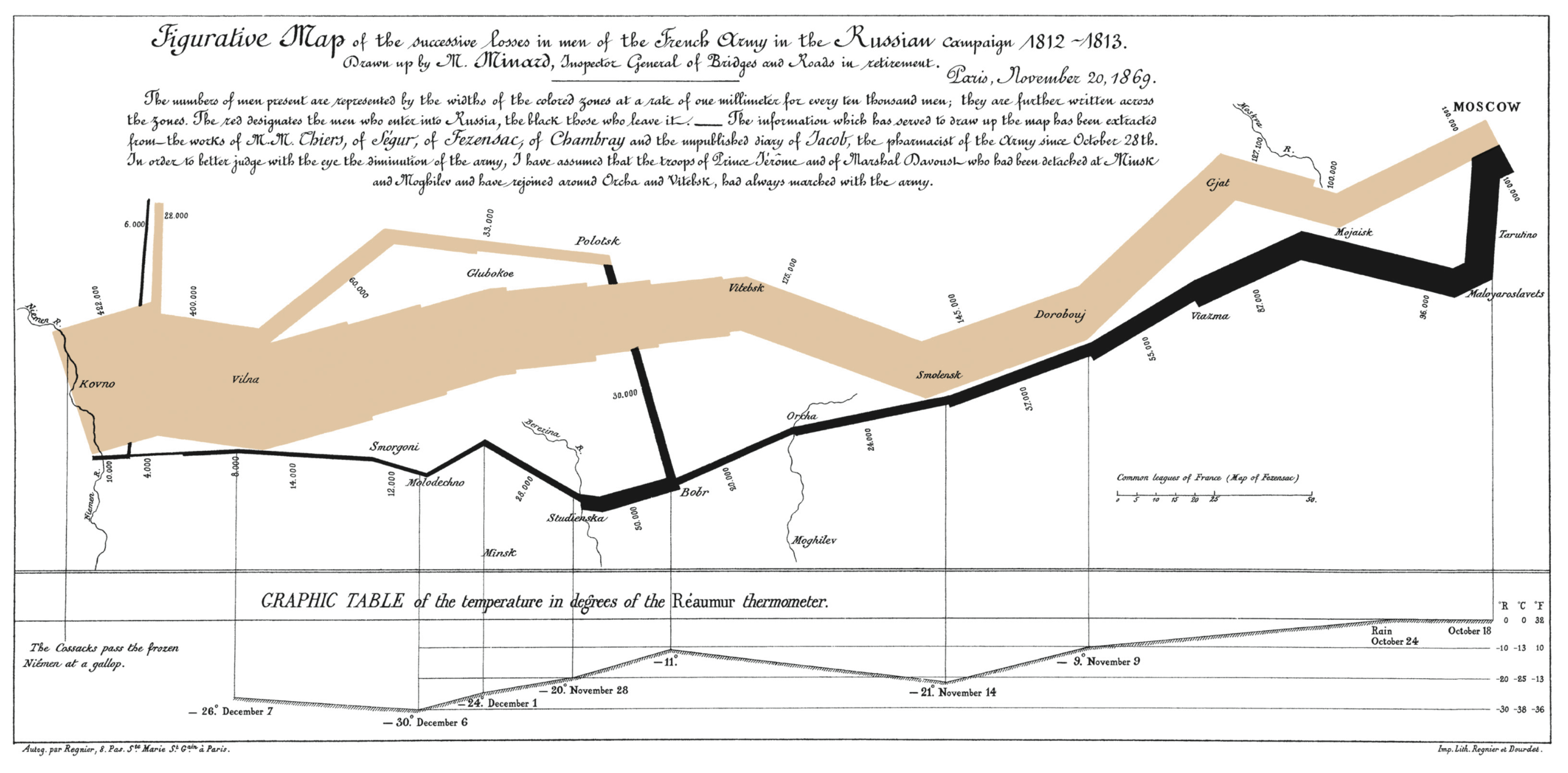
Figurative map of the successive losses of the French Army in the Russian campaign, 1812-1813
One obstacle to creating elegant figures on the web is the difficulty of
handling different screen sizes, especially on the fly. Embedded iframe elements
are particularly troublesome. For these instances we provide a helper class,
iframe-wrapper, the most common use for which is probably YouTube videos, e.g.
<figure class="iframe-wrapper">
<iframe
width="853"
height="480"
src="https://www.youtube.com/embed/YslQ2625TR4"
frameborder="0"
allowfullscreen
></iframe>
</figure>You can use this class on a div instead of a figure, with slightly different results but the same general effect. Experiment and choose depending on your application.
Code
Technical jargon, programming language terms, and code samples are denoted with
the code class, as I've been using in this document to denote HTML. Code needs
to be monospace for formatting purposes and to aid in code analysis, but it must
maintain its readability. To those ends, Tufte CSS follows GitHub's font
selection, which shifts gracefully along the monospace spectrum from the elegant
but rare Consolas all the way to good old reliable Courier.
Extended code examples should use a pre tag with class code. This adds
control over indentation and overflow as well:
;; Some code examples in Clojure. This is a comment.
;; applying a function to every item in the collection
(map tufte-css blog-posts)
;;;; if unfamiliar, see http://www.lispcast.com/annotated-map
;; side-effecty loop (unformatted, causing text overflow) - from https://clojuredocs.org/clojure.core/doseq
(doseq [[[a b] [c d]] (map list (sorted-map :1 1 :2 2) (sorted-map :3 3 :4 4))] (prn (* b d)))
;; that same side-effecty loop, formatted
(doseq [[[a b] [c d]] (map list
(sorted-map :1 1 :2 2)
(sorted-map :3 3 :4 4))]
(prn (* b d)))
;; If this proselytizing has worked, check out:
;; http://howistart.org/posts/clojure/1Epilogue
Many thanks go to Edward Tufte for leading the way with his work. It is only through his kind and careful editing that this project accomplishes what it does. All errors of implementation are of course mine.
Lists
Here is an example of an unordered list, it looks a bit "codey".
- Roses
- Violets
- Carnations
- Peonies
And here is an ordered list:
- Spectacles
- Testicles
- Wallet
- Watch
Tables
Tables aren't part of the core Markdown spec, but they are part of GFM and Markdown Here supports them. They are an easy way of adding tables to your email -- a task that would otherwise require copy-pasting from another application.
Colons can be used to align columns.
| Tables | Are | Cool |
| ------------- | :-----------: | -----: |
| col 3 is | right-aligned | \$1600 |
| col 2 is | centered | \$12 |
| zebra stripes | are neat | \$1 |
There must be at least 3 dashes separating each header cell. The outer pipes (|)
are optional, and you don't need to make the raw Markdown line up prettily. You
can also use inline Markdown.
| Markdown | Less | Pretty |
| -------- | --------- | ---------- |
| _Still_ | `renders` | **nicely** |
| 1 | 2 | 3 |Colons can be used to align columns.
| Tables | Are | Cool |
|---|---|---|
| col 3 is | right-aligned | $1600 |
| col 2 is | centered | $12 |
| zebra stripes | are neat | $1 |
There must be at least 3 dashes separating each header cell. The outer pipes (|) are optional, and you don't need to make the raw Markdown line up prettily. You can also use inline Markdown.
| Markdown | Less | Pretty |
|---|---|---|
| Still | renders | nicely |
| 1 | 2 | 3 |
More Code
function foo(bar) {
var a = 42,
b = "Prism"
return a + bar(b)
}
foo()